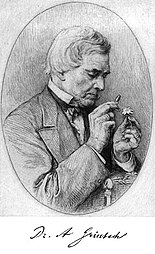| August Heinrich Rudolf Grisebach | |
|---|---|
 | |
| Born | (1814-04-17)17 April 1814 Hanover, Electorate of Hanover, Holy Roman Empire |
| Died | 9 May 1879(1879-05-09) (aged 65) Göttingen, Province of Hanover, Kingdom of Prussia |
| Scientific career | |
| Author abbrev. (botany) | Griseb. |
August Heinrich Rudolf Grisebach (pronounced [ˈaʊɡʊst ˈhaɪnʁɪç ˈʁuːdɔlf ˈɡʁiːzəbax]; 17 April 1814 – 9 May 1879) was a German botanist and phytogeographer.
Biography
Grisebach studied at the Lyceum in Hanover, the cloister-school at Ilfeld, and the University of Göttingen. He graduated in medicine from the University of Berlin in 1836. He undertook expeditions to Provence, Turkey, the Balkans, and Norway. In 1837 he became associate professor and in 1847 full professor at the medical faculty in Göttingen and was named director of the botanical garden there in 1875. While his main fields of interest were phytogeography and systematics, especially the Gentianaceae and Malpighiaceae, he considered his Flora of the British West Indian Islands his most important work. Much of his collection, especially the types of species described by him, are housed at the Göttingen University Herbarium. His taxonomic classification is set out in his Grundriss der systematischen Botanik (1854). His son Eduard was an author, lawyer and diplomat.
Selected works
- Grisebach, August (1854). Grundriss der systematischen Botanik für akademische Vorlesungen entworfen (in German). Göttingen: Dieterichschen Buchhandlung. (Grundr. Syst. Bot.: Schema p. 68)
- Die Vegetation der Erde nach Ihrer Klimatischen Anordnung (The Earth's vegetation after its climatic arrangement), 1872 (1st Edition), 1884 (2nd Edition).
- Flora of the British West Indian Islands, Lovell Reeve & Co., London, 1864
References
- Göttingen University, Department of Systematics, Biodiversity and Evolution of Plants (with Herbarium)
- International Plant Names Index. Griseb.
Bibliography
- Some Biogeographers, Evolutionists and Ecologists: Chrono-Biographical Sketches
- Detailed biography at the Allgemeine Deutsche Biographie
- Biographical entry in Meyers Konversationslexikon
- Obituary in Botanische Zeitung 1879
External links
- Complete bibliography on WorldCat
- Plantae Wrightianae e Cuba Orientali at Botanicus
- Catalogus plantarum cubensium (Catalog of Plants of Cuba) 1866, at Botanicus
- Plantae Wrightianae e Cuba Orientali by A. Grisebach at the Biodiversity Heritage Library.
- Grisebach, A. (1857) Systematische Untersuchungen über die Vegetation der Karaiben, insbesondere der Insel Guadeloupe at the Biodiversity Heritage Library.
- Malpighiaceae/Grisebach
| List of systems of plant taxonomy | |||||||||||||||||||||||||||||||||||||||||||||||||||
|---|---|---|---|---|---|---|---|---|---|---|---|---|---|---|---|---|---|---|---|---|---|---|---|---|---|---|---|---|---|---|---|---|---|---|---|---|---|---|---|---|---|---|---|---|---|---|---|---|---|---|---|
| This is a selected list of the more influential systems. There are many other systems, for instance a review of earlier systems, published by Lindley in his 1853 edition, and Dahlgren (1982). Examples include the works of Scopoli, Ventenat, Batsch and Grisebach. | |||||||||||||||||||||||||||||||||||||||||||||||||||
| |||||||||||||||||||||||||||||||||||||||||||||||||||
| |||||||||||||||||||||||||||||||||||||||||||||||||||
| |||||||||||||||||||||||||||||||||||||||||||||||||||
| |||||||||||||||||||||||||||||||||||||||||||||||||||